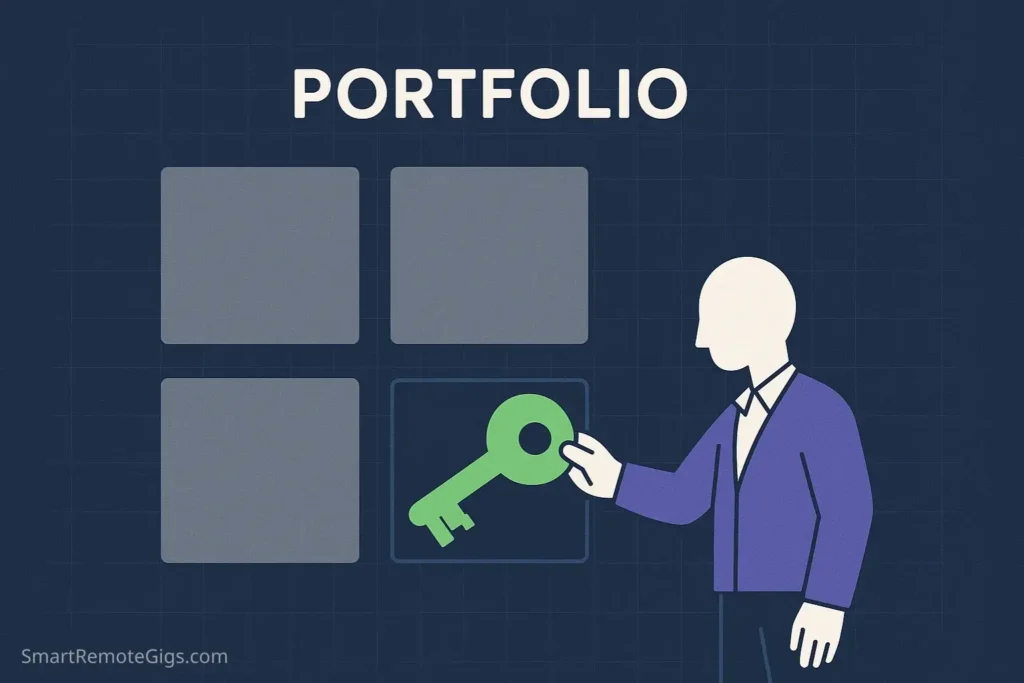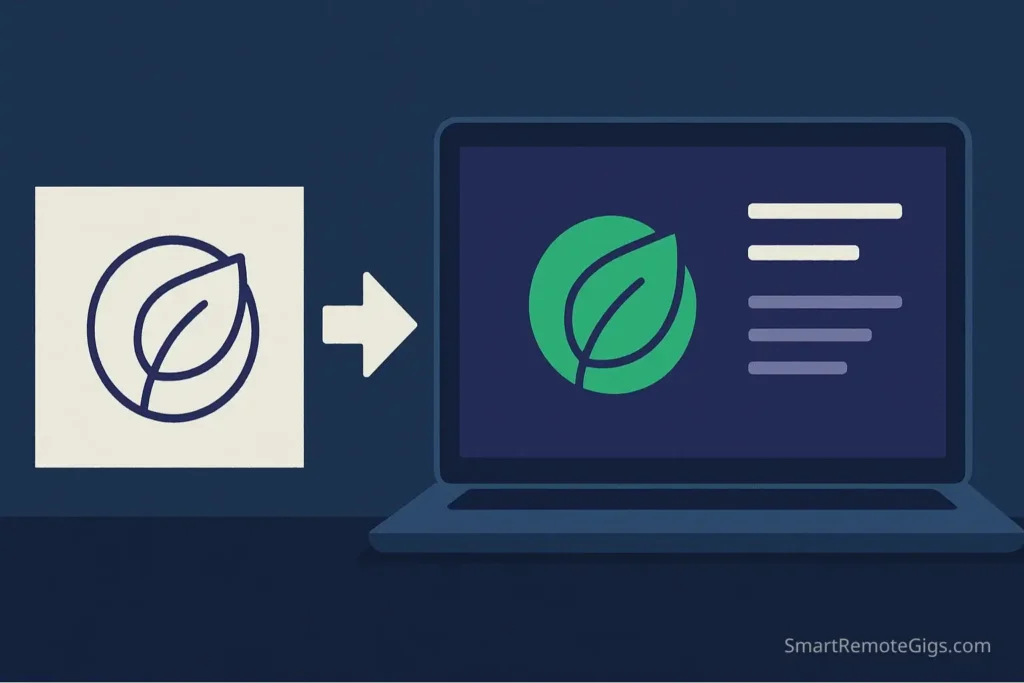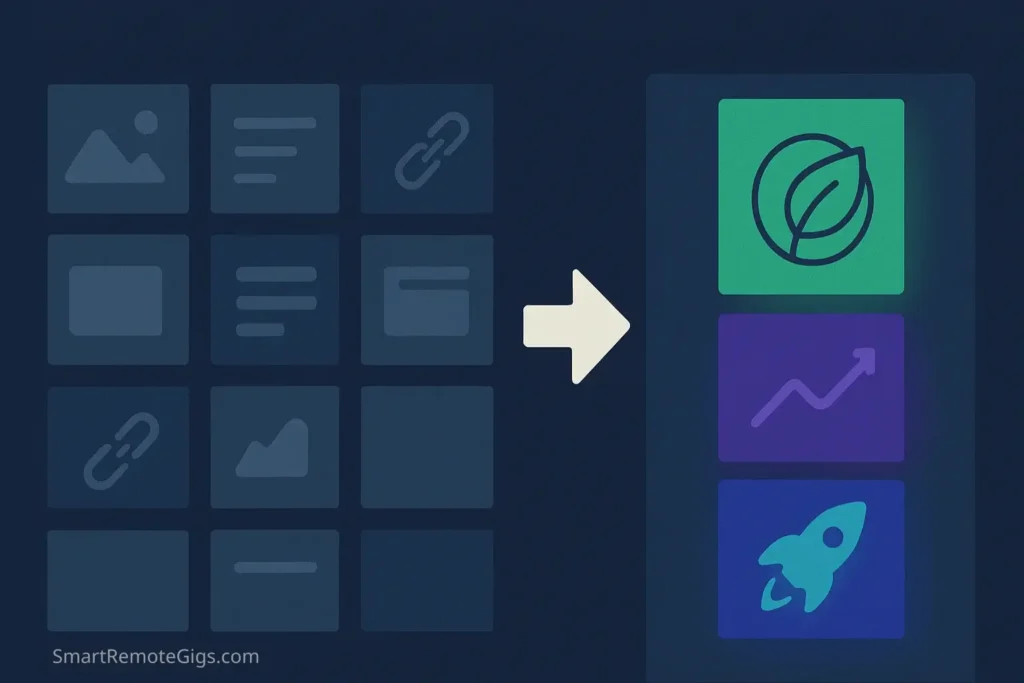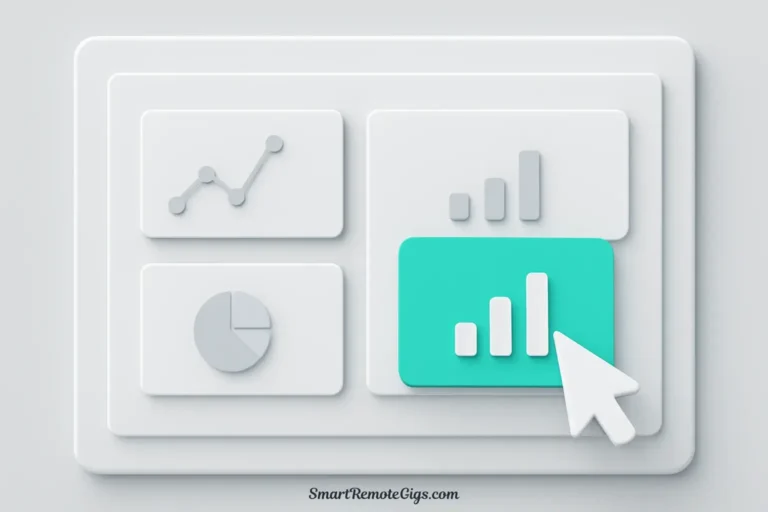Build a Fiverr Portfolio from Scratch — it sounds impossible when you’re just starting out with no clients, no reviews, and no social proof. But the truth is, every top Fiverr seller started in the exact same place.
If you’ve ever thought:
“I need clients to build a portfolio, but I need a portfolio to get clients” — you’re not alone.
In this guide, you’ll learn how to create a Fiverr portfolio from scratch, using strategic spec work that attracts buyers before your first sale. No more underpricing or chasing low-ball offers.
👉 And once your portfolio is ready, here’s your next step: Get Your First Fiverr Client: A No-BS Guide That Works
We’ll walk you through how to showcase your skills with samples that make buyers say: “This seller knows what they’re doing.”
👤 About the Author: Jason Carter remembers staring at his empty Fiverr portfolio, feeling the classic “no experience, no clients” catch-22. Instead of waiting, he created three powerful spec pieces that landed him his first high-paying client within a week. He credits this proactive strategy as the single most important factor in becoming a Top Rated Seller.
💡 Key Ideas for Your Zero-Client Portfolio
- Don’t Wait for Permission: Create your own work samples (spec work) to prove your skills before you have clients.
- Quality Over Quantity: 3 amazing spec pieces are better than 10 mediocre ones. Focus on showcasing your absolute best work.
- Present Like a Pro: Create a mini case study for each piece explaining the “problem,” your “solution,” and your “process.”
- Tailor to Your Target: If you want to work with tech startups, create spec work for tech startups. Attract the clients you want.
What is Spec Work (And Why It’s Your Secret Weapon)

Spec work (short for “speculative work”) means creating a project for a fictional client or as a proactive sample for a real company, purely for your portfolio. You’re not doing it for free for a client – you’re investing in your own future by creating social proof of your abilities.
Think of it as your freelance audition reel.
Why spec work is more powerful than you think:
It demonstrates your process, not just your skills. Anyone can claim they’re a great designer or writer. Spec work shows exactly how you approach problems, what your finished work looks like, and the level of professionalism buyers can expect.
It lets you choose your best work. Unlike client work (where you’re constrained by their vision, budget, and feedback), spec work lets you showcase your skills at their absolute best. You control the brief, the timeline, and the final result.
It builds confidence before you need it. Walking into client conversations with a portfolio of strong work changes your entire energy. You’re no longer hoping they’ll take a chance on you – you’re showing them exactly what they’ll get.
It positions you as an expert from day one. A well-crafted spec piece with a professional case study explanation makes you look like someone with years of experience, even if you’re just starting out.
The key is creating spec work that looks and feels like real client projects. This isn’t about making obviously fake samples – it’s about creating work so professional that buyers can’t tell it wasn’t commissioned.
How to Build Your Portfolio: Ideas by Profession

The best spec work solves real problems for real companies, even if they didn’t ask for it. Here are specific, actionable ideas organized by the most popular Fiverr categories:
For Graphic Designers
- Logo Design: Create a complete rebrand for a small local business with an outdated logo. Research their industry, understand their target audience, and design 2-3 logo concepts with a brand guidelines document. Present it as “Conceptual Rebrand for [Business Name].”
- Social Media Graphics: Choose a brand you admire and create a cohesive set of 5 Instagram post templates in their style. Include different post types (quote graphics, product features, behind-the-scenes). This shows you understand brand consistency and social media design principles.
- Print Design: Design a menu for a fictional restaurant, a flyer for a community event, or business cards for a made-up consulting firm. Focus on typography, hierarchy, and practical design considerations that show you understand print requirements.
- Web Design: Create a homepage mockup for a fictional SaaS company, local service business, or e-commerce store. Include multiple sections (hero, features, testimonials, CTA) and present it as a complete case study with your design decisions explained.
Pro tip: Use placeholder text and stock photos, but make everything look cohesive and intentional. The goal is to show your design skills, not your photography or copywriting abilities.
For Writers
- Blog Posts: Write 2-3 high-quality blog posts on trending topics in industries you want to work in. If you want to write for SaaS companies, create posts about productivity, remote work, or business automation. Publish them on Medium or your own blog for credibility.
- Website Copy: Find a small business with terrible website copy and rewrite their homepage, about page, or service descriptions. Present it as “Website Copy Optimization for [Business Type]” and explain what wasn’t working and how your version improves it.
- Email Marketing: Create a 5-email welcome sequence for a fictional online course, subscription box, or coaching program. Show different email types (welcome, value-add, sales, story-driven) to demonstrate your range.
- Product Descriptions: Write compelling descriptions for products on Etsy, Amazon, or any e-commerce site that has bland, feature-focused copy. Focus on benefits, emotional connection, and SEO optimization.
- Case Studies: Write a detailed case study about a “client” project where you increased their email open rates, improved their website conversions, or boosted their social media engagement. Use realistic but impressive metrics.
For Social Media Managers
- Content Calendar: Create a 30-day content calendar for a fictional business in an industry you understand. Include post types, captions, hashtag research, and posting schedule. Show that you understand content strategy, not just pretty pictures.
- Instagram Audit: Choose a real business with inconsistent branding and create a detailed audit of their Instagram presence. Explain what’s not working and provide specific recommendations for improvement.
- Social Media Templates: Design 10 Instagram post templates for a specific industry (fitness, beauty, business coaching). Include different layouts for quotes, tips, behind-the-scenes, and promotional content.
- Campaign Strategy: Develop a complete social media campaign for a fictional product launch, including pre-launch buzz, launch day content, and follow-up engagement strategies. Show you understand campaign thinking, not just individual posts.
- Analytics Report: Create a mock monthly analytics report showing growth metrics, top-performing content, and strategic recommendations. Use realistic data and present it professionally.
For Voiceover Artists
Commercial Samples: Record 3-4 different commercial scripts in different styles (conversational, energetic, professional, warm). Choose scripts for different industries (healthcare, technology, food) to show your range.
Narration Demo: Record a 2-3 minute sample of educational or documentary-style narration. Choose content from a public domain source or write your own script about a topic you’re knowledgeable about.
Character Voices: Create samples of different character voices for animation, video games, or audiobooks. Show your range without going overboard – quality over quantity.
IVR/Phone System: Record professional phone system messages, including hold music introductions, menu options, and automated responses. This is a huge market that many voice artists overlook.
Podcast Intro: Create 2-3 different podcast intro samples for fictional shows in different genres (business, comedy, true crime). Show you understand pacing, energy, and brand alignment.
For Video Editors
YouTube Intro/Outro: Create professional intro and outro sequences for fictional YouTube channels in different niches (gaming, education, lifestyle). Show motion graphics, text animation, and brand integration.
Product Demo: Edit a product demonstration video using stock footage, showing before/after, features, and benefits. Focus on pacing, music selection, and clear storytelling.
Social Media Videos: Create short-form content optimized for TikTok, Instagram Reels, or YouTube Shorts. Show you understand platform-specific requirements and trending formats.
Testimonial Compilation: Edit together customer testimonials (you can use actors or friends) into a compelling 60-90 second video that builds trust and social proof.
Event Highlight Reel: Create a 2-3 minute highlight reel of a fictional conference, wedding, or corporate event using stock footage. Show your ability to capture emotion and tell a story.
For Web Developers
Landing Page: Build a complete landing page for a fictional SaaS product, including hero section, features, pricing, and testimonials. Make it fully responsive and include subtle animations.
E-commerce Product Page: Create a detailed product page with image galleries, reviews, related products, and add-to-cart functionality. Show you understand conversion optimization.
Portfolio Website: Build a portfolio site for a fictional photographer, designer, or consultant. Include case studies, contact forms, and professional presentation.
Dashboard Interface: Create a clean, functional dashboard for a fictional app or software product. Include data visualization, user controls, and intuitive navigation.
WordPress Theme: Develop a custom WordPress theme for a specific industry (restaurants, fitness, consulting) and document all the features and customization options.
How to Present Your Spec Work Professionally

The difference between spec work that gets you hired and spec work that gets ignored is in the presentation. Here’s how to make your samples look like legitimate client projects:
Label Everything Clearly
Never try to pass off spec work as real client work – it’s dishonest and you’ll get caught. Instead, use clear, professional labels:
- “Conceptual Rebrand for [Business Name]”
- “Sample Blog Post Series”
- “Portfolio Piece: E-commerce Website Design”
- “Spec Work: Social Media Campaign Strategy”
Create Case Studies
Don’t just show the final result – explain your process. For each spec piece, include:
- The Challenge: What problem were you solving?
- The Solution: What approach did you take and why?
- The Process: What steps did you follow?
- The Result: What would the impact be?
This shows strategic thinking, not just execution skills.
Focus on Quality Over Quantity

Three amazing spec pieces are infinitely better than ten mediocre ones. Buyers scan portfolios quickly – make sure every piece you show is something you’re genuinely proud of.
Use Professional Mockups
Present your work in realistic contexts. Show logos on business cards and signage, display websites on laptop screens, present social media posts in phone mockups. This attention to detail makes everything look more legitimate.
Include Your Thinking
Add brief descriptions explaining your creative decisions. Why did you choose that color palette? What inspired the layout? How does this solution address the target audience’s needs? This shows you’re not just following tutorials – you’re thinking strategically.
Keep It Relevant
Tailor your portfolio to the types of clients you want to attract. If you want to work with tech startups, create spec work for SaaS companies. If you want to work with local businesses, create samples for restaurants, fitness studios, or retail stores.
Make It Easy to Contact You
Every portfolio piece should reinforce that you’re available for hire. Include clear contact information and links to your Fiverr profile. Make it as easy as possible for impressed viewers to become paying clients.
Remember: your portfolio is often the first impression potential clients have of your work. Make it count.
Your Next Steps: From Spec Work to Paying Clients

Building a portfolio with spec work is just the beginning. Here’s how to leverage it effectively:
Start with one perfect piece. Don’t try to create a full portfolio overnight. Focus on creating one spectacular spec project that showcases your best skills. Use it to land your first client, then build from there.
Get feedback before you launch. Share your spec work with other professionals in your field, mentors, or even potential clients. Their input will help you refine your approach before you start pitching.
Use spec work in your Fiverr gig images. Your portfolio pieces can double as compelling visuals for your service listings. Show potential buyers exactly what they’ll get.
Document your process. Keep notes about what worked, what didn’t, and what you learned. This information becomes valuable for client conversations and future projects.
Update regularly. As your skills improve and you gain real client work, replace older spec pieces with stronger examples. Your portfolio should evolve with your abilities.
The goal isn’t to stay in spec work forever – it’s to create enough social proof to attract your first paying clients. Once you have a few successful projects under your belt, client work will become your primary portfolio content.
But here’s the thing: even established freelancers use spec work to break into new industries, test new styles, or showcase skills they haven’t had client opportunities to demonstrate. It’s a tool that remains valuable throughout your entire freelancing career.
Your challenge: Create your first spec piece this week. Choose one project from the ideas above, spend 2-3 hours creating something you’re genuinely proud of, and add it to your portfolio. That’s it.
You don’t need permission to start showcasing your skills. You don’t need to wait for the perfect client to come along. You have everything you need right now to build a portfolio that attracts the kinds of clients you want to work with.
The only question is: which spec project will you start with?







